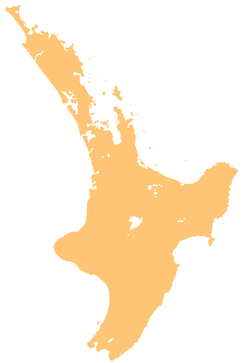Waihi
| Waihi | |
|---|---|
| Town | |

A view from North Waihi looking south down main street.
|
|
| Location of Waihi within the North Island | |
| Coordinates: 37°23′S 175°50′E / 37.383°S 175.833°ECoordinates: 37°23′S 175°50′E / 37.383°S 175.833°E | |
| Country | New Zealand |
| Region | Waikato |
| Territorial authority | Hauraki District |
| Population (June 2016) | |
| • Total | 5,150 |
| Time zone | NZST (UTC+12) |
| • Summer (DST) | NZDT (UTC+13) |
| Postcode(s) | 3610 |
Waihi is a town in Hauraki District in the North Island of New Zealand, especially notable for its history as a gold mine town. It had a population of 4,527 at the 2013 census.
The town is at the foot of the Coromandel Peninsula, close to the western end of the Bay of Plenty. The nearby resort town of Waihi Beach, ten kilometres to the east, is often regarded as the westernmost point of the Bay of Plenty region. To the west are the hills of the Kaimai Ranges. Road access from this direction is through the winding Karangahake Gorge road. Waihi has warm and temperate climate but unusually high rainfall for New Zealand's east coast with an average annual rainfall of 2147 mm.
Waihi is located in the Coromandel district, which was one of the great gold mining districts of the world. The township grew around the mining operations since the discovery of gold in 1878 by prospectors John McCombie and Robert Lee. The samples of rock they had sent to be assayed were not considered worthwhile, so they left the area.
Their claim was taken over by William Nicholl in 1879. He marked out 5 acres (20,000 m2), calling his claim 'Martha' after a family member. Several smaller claims were later merged to form the Martha Company. By 1882 the first battery to break gold-bearing rock was in operation. The Martha Mine eventually grew into one of the world's most important gold and silver mines, after industrial cyanide processes made recovering gold from the low-grade ores easier. Waihi prospered with the mine, by 1908 being the fastest-growing town in the Auckland Province, three times the size of Hamilton.
Waihi was also a major centre of union unrest in New Zealand during the early years of the 20th century. The 1912 miners' strike led to violence, including the death of unionist Fred Evans in an incident which still causes some resentment in the town.
By 1952, when the mighty Martha Mine closed, around 5.6 million ounces (174,160 kg) of gold and 38.4 million ounces (1,193,180 kg) of silver had been produced from 11,932,000 tonnes of ore. Mining stopped in 1952 after a total of 160 km of tunnels had been driven into the quartz of Martha Hill, not because the Martha had run out of gold, but rather because of fixed gold prices, lack of manpower, and increasing costs. Mining in the Coromandel Peninsula had otherwise ceased by the 1980s.
...
Wikipedia

